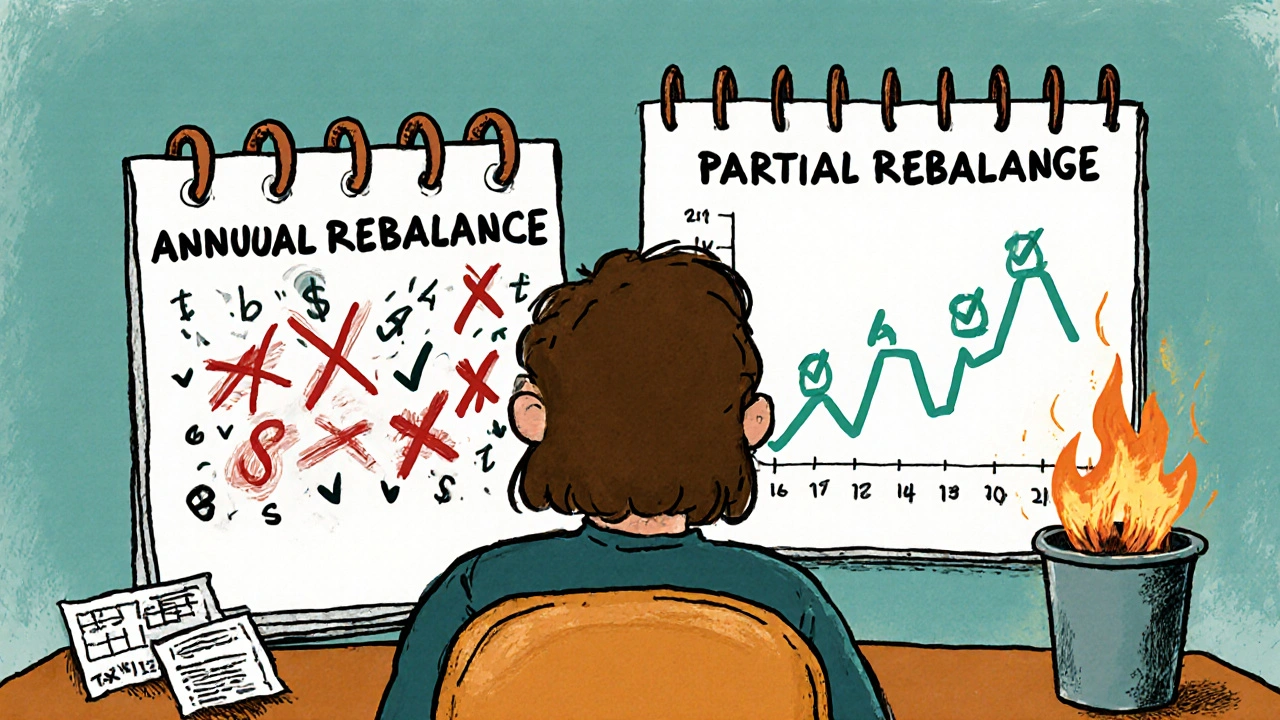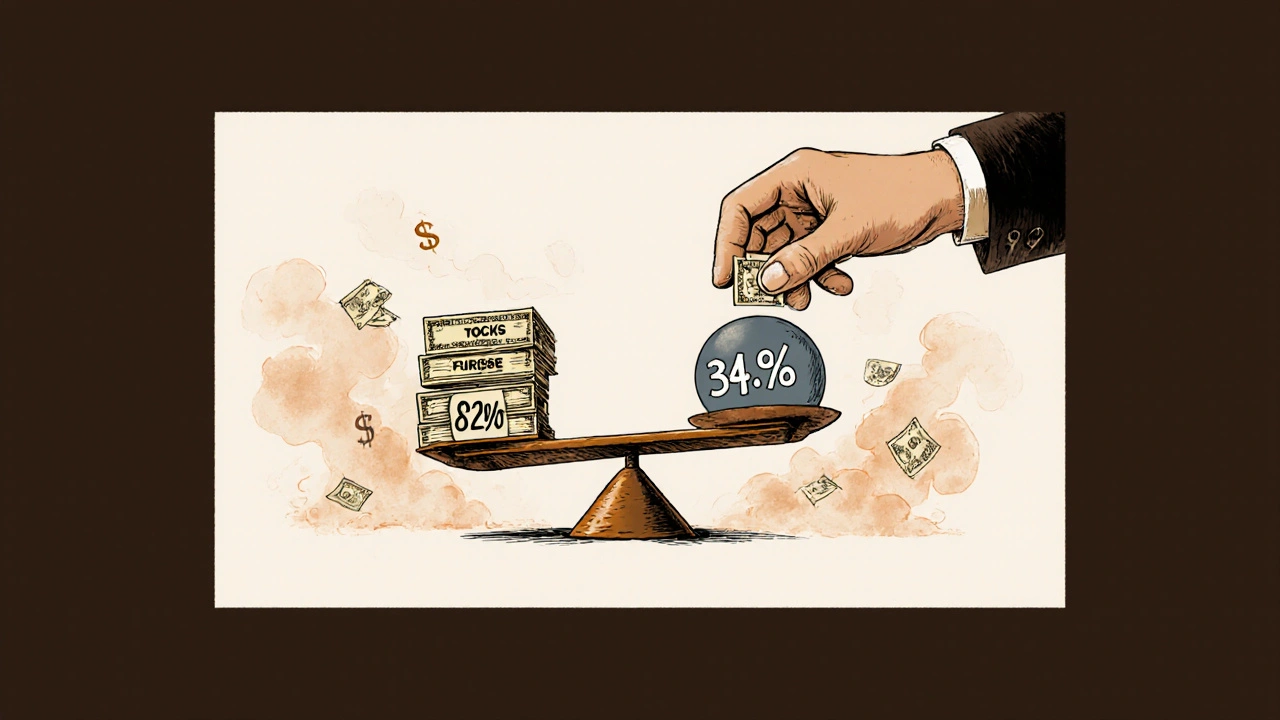Partial Rebalancing Calculator
Your Portfolio Analysis
Most people think rebalancing means snapping your portfolio back to its original target-sell the winners, buy the losers, done. But what if you could get 85% of the risk control with only half the trading? That’s the quiet revolution behind partial rebalancing.
Full rebalancing sounds clean. You set a 60/40 stock-to-bond split. When stocks surge and your portfolio becomes 68/32, you sell 8% of your stocks and buy bonds until you’re back at 60/40. Simple. But it’s expensive. Taxes. Commissions. Slippage. In taxable accounts, those costs can eat up 0.3% of your returns every year-money that’s gone forever.
Partial rebalancing says: don’t fix it all. Fix just enough.
How Partial Rebalancing Actually Works
Instead of correcting 100% of the drift, you correct 50% to 75%. Let’s say your target is 60% stocks, 40% bonds. Markets move. Your portfolio drifts to 65% stocks, 35% bonds. That’s a 5% absolute deviation.
Full rebalancing? Sell 5% of your stocks. Buy 5% in bonds. Back to 60/40.
Partial rebalancing? Sell only 2.5% of your stocks. Buy 2.5% in bonds. Now you’re at 62.5/37.5. You’ve reduced the drift by half-without triggering the full tax bill or trading cost.
This isn’t guesswork. It’s backed by data. Vanguard’s research shows partial rebalancing cuts transaction costs by 40-60% compared to full rebalancing. Russell Investments tracked 500 institutional portfolios and found it kept 85-90% of the risk-reduction benefits. You’re not giving up much. You’re saving a lot.
When to Trigger It
You don’t rebalance every month. You don’t even do it every quarter. You wait for a trigger.
Most professionals use a 5% absolute deviation as the trigger. That means if any asset class moves more than 5 percentage points from its target, you act. Some retail platforms use 8%. Institutional investors stick to 5%.
Why 5%? Because below that, the drift is usually noise. Above that, risk starts to build. A 60/40 portfolio drifting to 70/30 isn’t just off-target-it’s suddenly way more exposed to stock market crashes. That’s dangerous.
And you don’t need to rebalance on a calendar. Calendar rebalancing (like doing it every year) forces you to trade even when markets are quiet. Partial rebalancing is event-driven. You only act when the drift matters.
Why It Saves Money-And Taxes
Here’s the real win: taxes.
If you’re holding stocks in a taxable account and you sell them after a big run-up, you pay capital gains. If you sell 8% of your position in a tech stock that’s doubled in a year, you owe taxes on that entire gain. That’s a big hit.
With partial rebalancing, you sell only half as much. That cuts your tax bill roughly in half. Betterment’s data shows portfolios using partial rebalancing had 37% fewer taxable events. That’s not a small thing-it’s life-changing over 10 or 20 years.
And it’s not just taxes. Trading costs add up. Even $5 per trade adds up if you’re doing it every year on a $500,000 portfolio. Partial rebalancing reduces trading frequency by over 60%, according to Duke University’s research. Fewer trades. Less friction. More money staying in your account.

What You Give Up (And Why It’s Worth It)
Yes, there’s a trade-off. Your portfolio won’t be perfectly on target. Tracking error-the difference between your actual allocation and your target-will be higher. Russell Investments found partial rebalancing leads to 1.8 to 2.3 times more tracking error than full rebalancing.
So what? You’re still within a reasonable range. A 62.5/37.5 portfolio isn’t wildly risky. It’s still diversified. It’s still aligned with your long-term goals. The extra 2.5% in stocks? It’s not a gamble. It’s a cost-saving buffer.
And here’s the kicker: in strong trending markets, full rebalancing actually hurts you. During the 2020-2021 tech rally, portfolios that fully rebalanced sold off tech stocks as they rose, then bought them back later at higher prices. Partial rebalancers held onto more of their winners. They outperformed by 1.2-1.8% over that period.
Full rebalancing isn’t smart. It’s mechanical. It buys losers and sells winners-exactly what you’re told not to do in investing. Partial rebalancing respects market momentum while still keeping risk in check.
Who Should Use It?
Not everyone needs it. But if you fit any of these profiles, you’re a prime candidate:
- You have a taxable investment account (not an IRA or 401(k))
- Your portfolio is over $100,000 (transaction costs start to matter)
- You hold individual stocks or ETFs with high turnover
- You’re sensitive to tax bills or hate selling recent winners
- You’re working with a financial advisor who’s willing to customize
For retirement accounts with no tax consequences, full rebalancing is fine. But in taxable accounts? Partial is the smarter move.
Advisors are catching on. In a 2022 survey of 1,200 financial advisors, 68% reported using partial rebalancing. Eighty-two percent said the #1 reason was reduced tax impact. Reddit threads, Bogleheads forums, and financial blogs are full of people who switched and saw their tax bills drop by hundreds or even thousands of dollars.
How to Set It Up
You don’t need fancy software-but you do need a plan.
Start with your target allocation. Say 60% stocks, 40% bonds.
Set your trigger: 5% absolute deviation. That means if stocks hit 65% or drop to 55%, you act.
Decide your correction rate: 50% is the industry standard. Some use 75% if you’re in a high-tax state or have a very tax-sensitive account.
Document it. Write it down. A formal rebalancing policy isn’t just for institutions. It’s for anyone who wants to avoid emotional decisions. What’s your trigger? What’s your correction? What if the market crashes? What if it surges? Have it written. Stick to it.
Platforms like Betterment, Envestnet, and Charles River IMS already support partial rebalancing. If you’re using a robo-advisor, check your settings. Many now offer it as a default option.

The Future Is Partial
This isn’t a niche trick. It’s becoming standard.
Vanguard rolled partial rebalancing into all its taxable account algorithms in 2024. Man Group launched a version that combines it with trend-following signals to delay rebalancing during strong rallies-boosting returns by 0.31% annually. MIT researchers found machine learning models that adjust correction rates based on market volatility can add another 0.47% to risk-adjusted returns.
Cerulli Associates predicts 75% of financial advisors will use partial rebalancing by 2027. Why? Because clients are asking for it. They’re tired of paying taxes on paper gains. They want to stay invested without being forced to sell.
And the data doesn’t lie. You get almost all the risk control. You pay far less in costs. You sleep better knowing you’re not selling your winners just because the market moved.
Common Misconceptions
Some say: “If you don’t rebalance fully, you’re market timing.”
No. You’re not predicting the future. You’re reducing friction. You’re not saying “stocks will keep rising.” You’re saying “I’m okay with a 62.5/37.5 portfolio for now-it’s still within my risk tolerance.”
Others say: “It’s too complicated.”
It’s simpler than you think. You’re not calculating formulas. You’re just doing half the work. You’re trading less. You’re paying less. You’re holding more.
And Nobel laureate Eugene Fama’s argument-that all rebalancing is market timing-isn’t wrong. But partial rebalancing is the *least* market-timing version of rebalancing. It’s the most passive way to still manage risk.
Bottom Line
Partial rebalancing isn’t about being clever. It’s about being smart with your money.
If you’re in a taxable account and your portfolio has drifted, you don’t have to fix everything. Fix enough. Save the rest.
It’s not magic. But it’s one of the few investment strategies that actually saves you money without requiring you to predict the market. Just reduce the cost of staying on track-and keep more of what you’ve already earned.

Comments (3)
Dave McPherson
Oh, so now we're romanticizing under-rebalancing like it's some kind of financial Zen koan? Cute. Let me guess-you also think ‘buy and hold’ means ‘buy, hold, and ignore until your 60/40 becomes 80/20 and you cry during the next crash.’ Vanguard’s data? Sure, but their models assume you’re not some amateur with $120k in NVDA and zero emotional discipline. Partial rebalancing only works if you have a spine of titanium and a spreadsheet that updates in real-time. Most people? They’ll see ‘sell 2.5%’ and just… not do it. Then they wonder why their portfolio looks like a Jackson Pollock painting. This isn’t smart. It’s just lazy with a fancy name.
Julia Czinna
I actually switched to partial rebalancing last year after reading this exact breakdown, and it’s been a game-changer. I’m in a taxable account with a $180k portfolio, and my tax bill dropped by $2,100 in 12 months. I use a 5% trigger and 60% correction rate-no fancy tools, just a simple Google Sheet. I used to stress every quarter, selling winners I didn’t want to let go of. Now I breathe easier. The drift is barely noticeable, and honestly? My portfolio feels more aligned with my actual risk tolerance. It’s not about being perfect. It’s about being sustainable. Also, the fact that Betterment now defaults to this? That says everything.
RAHUL KUSHWAHA
Thanks for sharing this 😊 I live in India where tax rules are complicated, and I never realized rebalancing could be this thoughtful. I’ll try 5% trigger with 50% correction-sounds gentle enough for my small portfolio. No rush, just steady. Much better than panic-selling 😅